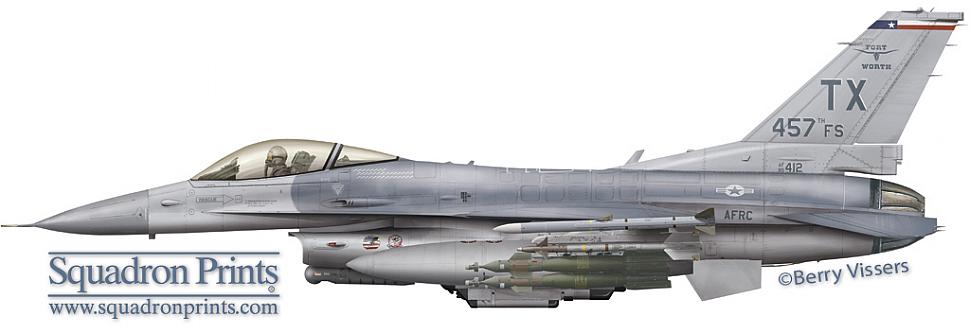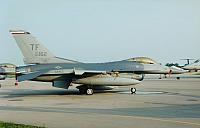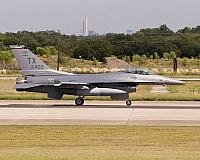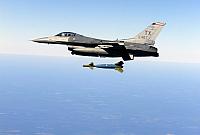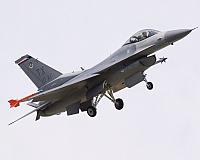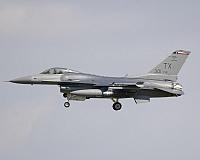 |
457th Fighter Squadron ( USAF AFRC)" Spads" |
 |
457 FS " Spads" ( USAF AFRC) | |||
| Status: |
Active
|
|||
| Version: | F-16C/D block 30 (small mouth) | |||
| Role: | Air Defense, Attack | |||
| Tailband: | Blue & White & Red (Texas flag) | |||
| Motto: | N/A | |||
| Badge: | N/A | |||
F-16 History
This squadron was reactivated in 1972 with F-105's. The 457th Fighter Squadron flew F-4D's in 1981 and converted to the F-4E in 1987. Conversion to the F-16 took place in December of 1990 when they received block 25's. The 'TF' tail code stands for 'Texas Falcons'. Carswell AFB was a perfect place to put an F-16 unit as it shares the same airfield as the Lockheed Fort Worth plant that manufactures F-16s. Starting on February 1st, 1992 the squadron changed from the 457th Tactical Fighter Squadron to the 457th Fighter Squadron. During the year of 1993, Carswell AFB closed as an active duty USAF base. Although the 457th Fighter Squadron remained active, the base became known as NAS Fort Worth. In 1994 the squadron celebrated its 50th Anniversary and painted the tail of aircraft #84-1245 with special markings. Each of the three white stripes on the rudder was to honor nine pilots (3 pilots per stripe) killed in the squadrons first few years of operations.
In mid 1996 the 457th FS converted from the block 25 to the block 30 and thus had to convert engine types from the P&W to the GE engine. Although a small mouth F-16 it is more combat capable then the block 25s. At the time of conversion the 457th FS also adopted a TX tail code which is the two letter code for Texas. The 704th FS previously carried the TX tail code but that unit stopped flying the F-16 in 1996.
The 457th FS went to war in 2001 when it deployed for Operation Southern Watch but ended up participating in Operation Enduring Freedom over Afghanistan as a result of the horrific terrorist attacks in the US on September 11th, 2001. In spite of fighting in Afghanistan, the 457th also had to keep up its role for OSW. The 457th FS took the Litening targeting pod and datalink which gave them an edge over many other aircraft that were deployed. These two items made their F-16s perfect for the Close-Air-Support role. The datalink is not the Link16 but a less costly version of that system.
Most missions over Afghanistan were more then ten hours. Weapon of choice was the 500 lb LGB-12. Night Vision Goggles were worn through out the combat mission
Described below is two extraordinary mission flown by the 457th FS into Afghanistan.
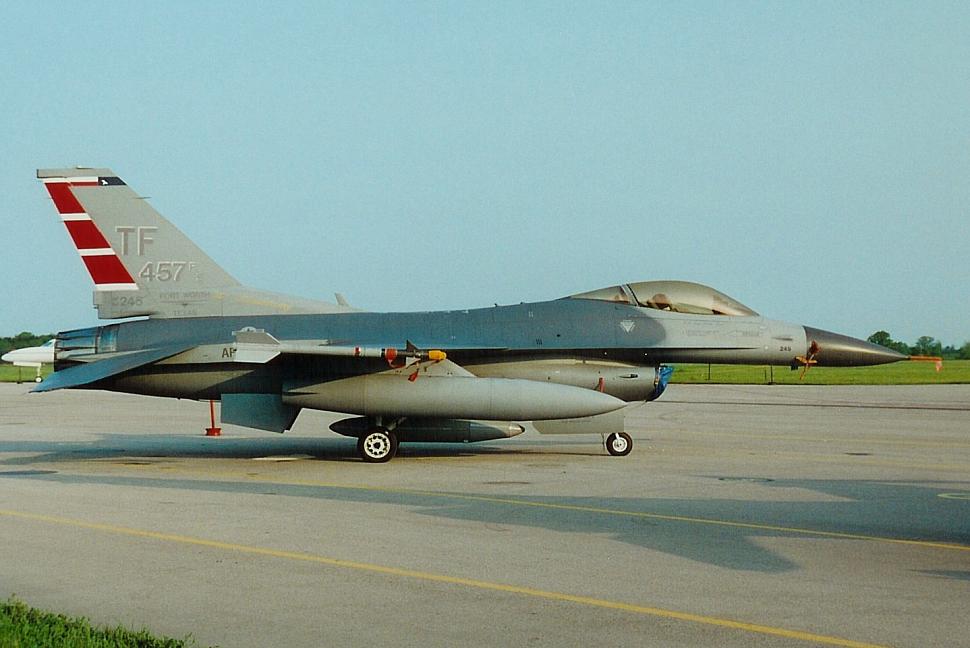
We never knew if we were going to drop until we checked in with a FAC. On my first mission, no one in my flight dropped. On my second mission, only my flight lead dropped. We flew against a Quonset hut area south of Kandahar. We showed up and checked in. We were working with a UAV. The UAV controller lased the target and we used our laser tracking capability to find the spot. We described what we saw and the controller confirmed the target. The controller asked if we wanted him to lase the bombs in. We said we would lase our own bombs. He then asked us to coordinate our attack with an incoming B-1. We held and waited for the B-1 to show. We circled back, joined with the B-1, and away we went. We used our NVGs to deconflict with the bomber. We had two separate targets about 700 meters apart. The controller wanted the bombs to hit at the same time. The B-1 dropped a JDAM, and my flight lead dropped a GBU-12. I flew in trail formation and captured both hits through my targeting pod. Just after the drop, the controller driving the UAV came over the radio and said that the Secretary of Defense was watching. Rumsfeld saw the bombs hit the targets in real-time. We walked into the chow hall the next day for breakfast and our video was playing on CNN. – Capt. David, 457th FS
- Courtesy Code One magazineI was working as an airborne FAC mission when I ran low on gas. I had several aircraft in the queue waiting to bomb, including a B-52. The tanker tracks were very close to the target area so I saddled up next to the tanker. I was on the boom getting gas and giving targeting coordinates to a B-52 dropping CBU-103s at the same time. – Maj. Chris, 301st FW
- Courtesy Code One magazineAs far as is known three pilots from the 457th Fighter Squadron have passed the 3000 hours mark. The first completed this milestone on August 10th, 1997 and that pilot was Major Michael Vastano. Lt.Col. John P. Thornton did so in July of 2000 followed by Col. Bill Schauffert in December of 2001. Col. Schauffert's 3000 hour milestone was broken in the skies over Afghanistan during Operation Enduring Freedom mission.
Heading into 2007 the 457th had 18 jets in the squadron. As a result of the 2005 Base Realignment and Closure (BRAC) committee recommendations, nine F-16Cs were transferred from the 149th FS/192nd FW of the Virginia ANG as the 149th FS became the USAFs first ANG associated F-22 Raptor unit at Langley AFB, Virginia. By the end of 2007 the squadron was operating 27 F-16C block 30 airframes. The 457th FS was fortunate as out of the 2005 BRAC decisions came the closure of two more F-16 Air Force Reserve Command squadrons. This left the 93rd FS and the 457th FS as the only F-16 operators in the AFRC out of the eight squadrons that flew the F-16s at one point in the 90s.
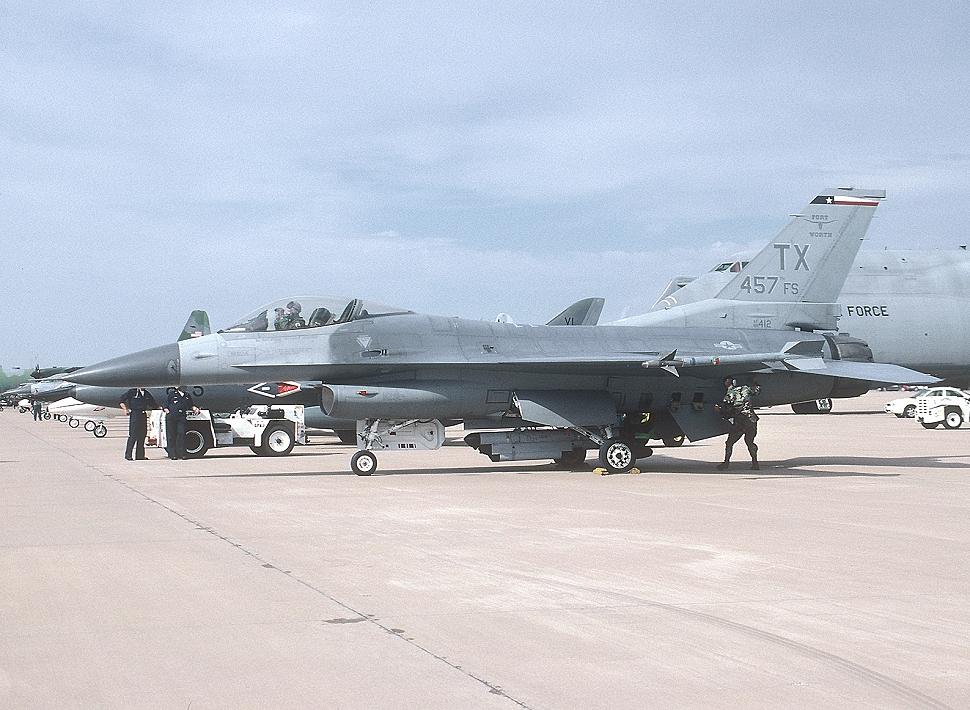
Aircraft Markings History
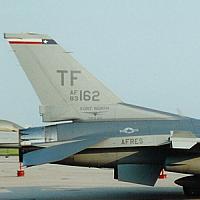
The base of the tail had the city name and state name which were separated by an image of a classic longhorn steers head. The 'TF' tail code stands for Texas Falcons which was changed when converting to the F-16. The tail band is simply a Texas flag.
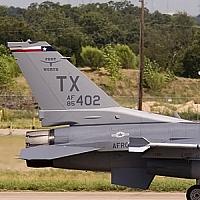
The markings were changed during the conversion to the block 30. The tail band remained a Texas flag. Fort Worth lettering was split with a cows skull and moved from the base of the tail to between tail code and the tail band. New was the 'TX' tail code which became available when the 704th FS lost their F-16s.
Unit History
- 1944: Activation of the squadron
- 1944: P-51D 'Mustang' (Pacific Theatre)
- 1945: Disbanded
- 1953: Activation of the squadron in Dow, Maine
- 1953: F-84 'Thunderjet'
- 1955: F-84 'Thunderjet' (Tinker AFB, Oklahoma)
- 1957: F-100 'Super Sabre'
- 1958: Disbanded
- 1972: Activation of the squadron in Carswell, Texas
- 1972: F-105D 'Thunderchief' (part of 301 TFW)
- 1981: F-4D 'Phantom II'
- 1987: F-4E 'Phantom II'
- 1991: F-16C/D 'Fighting Falcon' (part of 301 FW)
Deployments
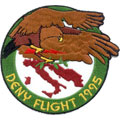 |
' Operation Deny Flight' |
| Aviano AB, Italy (December 1st, 1993 to January 3rd, 1994) | |
| Operation Deny Flight started on April 12th, 1993 and ran through to December 20th, 1995. It came about under a United Nations mandate and was a NATO enforcement of a no-fly zone over Bosnia. The 457th Fighter Squadron flew 368 missions in Operation Deny Flight out of Aviano AB, Italy. | |
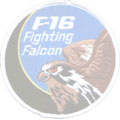 |
' Decisive Edge' |
| Aviano AB, Italy (December of 1995 to January of 1996) | |
| Operation Decisive Edge began on December 22nd, 1995 and was a follow-on to Operation Deny Flight, which the squadron participated in the previous year. The operation was a United Nations mandated no-fly zone for the airspace over Bosnia-Herzegovina. On December 21st, 1996 Operation Decisive Edge transitioned to Deliberate Guard. | |
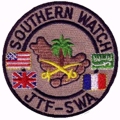 |
' Southern Watch' |
| Unknown location (May 29th, 1998 to ?, 1998) | |
| Operation Southern Watch was an operation which was responsible for enforcing the United Nations mandated no-fly zone below the 32nd parallel in Iraq. This mission was initiated mainly to cover for attacks of Iraqi forces on the Iraqi Shi’ite Muslims. This was a short deployment for the 457th FS which sent eight aircraft but their date of return is still yet unknown. Just prior to the deployment the squadron trained on the usage of Laser Guided Bombs. | |
 |
' Northern Watch' |
| Incirlik AB, Turkey (June of 1999) | |
| Operation Northern Watch was a US European Command Combined Task Force (CTF) who was responsible for enforcing the United Nations mandated no-fly zone above the 36th parallel in Iraq. This mission was a successor to Operation Provide Comfort which also entailed support for the Iraqi Kurds. Saw a little more action than most deployments to for ONW in which they dropped LGBs. | |
 |
' Northern Watch' |
| Incirlik AB, Turkey (June of 2000) | |
| For the second year in a row the 457th FS deployed to Incirlik AB, Turkey for Operation Northern Watch. Operation Northern Watch was a US European Command Combined Task Force (CTF) who was responsible for enforcing the United Nations mandated no-fly zone above the 36th parallel in Iraq. This mission was a successor to Operation Provide Comfort which also entailed support for the Iraqi Kurds. | |
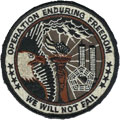 |
' Southern Watch/Enduring Freedom' |
| Ahmed Al Jaber AB, Kuwait (September of 2001 to December of 2001) | |
| Operation Southern Watch was an operation which was responsible for enforcing the United Nations mandated no-fly zone below the 32nd parallel in Iraq. This mission was initiated mainly to cover for attacks of Iraqi forces on the Iraqi Shi’ite Muslims. The 457th FS participated by sending three F-16s as part of a rainbow team on a regularly scheduled Aerospace Expeditionary Force rotation (AEF 7/8 - Cycle 2). Ten aircraft participated in total with the other units being the 93rd FS, 466th FS and pilots & crew only from the 302nd FS. They were to return in November of 2001 but this was extended because of the war in Afghanistan. Crew of the 457th FS covered the last portion of this deployment so hence they saw mostly the war in Afhanistan but still had to cover southern Iraq at the same time. | |
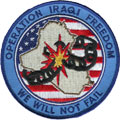 |
' Iraqi Freedom' |
| Balad AB, Iraq (September of 2005 to January 19th, 2006) | |
| USAF Reserve Command “Rainbow Team” deployment AEF 7/8 (Cycle 5) involving three units; the 93rd FS, 457th FS and the 466th FS. A total of twelve jets were sent between the three squadrons. Operation Iraqi Freedom was initiated in March of 2003 to drive Saddam Hussein from reigning Iraq. Over the next years, multiple units where tasked to perform air cover over Iraq in the wake of this war. | |
 |
' Iraqi Freedom' |
| Balad AB, Iraq (May 19th, 2007 to August 16th, 2007) | |
| The 93rd FS and 457th FS departed Fort Worth, Texas (home of the 457th) for Balad AB, Iraq in May of 2007 with twelve aircraft, six each squadron as part of AEF7/8 (Cycle 6). Both squadrons returned to Homestead AFB, Florida in August of 2007. | |
 |
' Iraqi Freedom' |
| Balad AB, Iraq (January 12th, 2009 to May 9th, 2009) | |
| Another rotation into Iraq as part of AEF7/8 (Cycle 7), also together with the other Reserve Command squadron, the 93rd. | |
 |
' Enduring Freedom' |
| Bagram AB, Afghanistan (December 15th, 2013 to May 3rd, 2014) | |
| This marked the first deployment of the squadron for Enduring Freedom. The squadron was rotated into theatre together with their all-time sisters of the 93rd FS. Replaced by the 100th Fighter Squadron. | |
 |
' Freedom's Sentinel' |
| Bagram AB, Afghanistan (April 27th, 2016 to August 7th, 2016) | |
| Deployed under the 457th Expeditionary Fighter Squadron for three months with between 200 to 300 airmen. At least one aircraft was borrowed by the 93rd Fighter Squadron for this deployment. |
F-16 Airframe Inventory
- All 457 FS F-16s in our F-16 Aircraft Database (past and current aircraft)
- Current 457 FS F-16s in our F-16 Aircraft Database
Photos
Special Thanks
Big thank you to Eric Hehs and Code One magazine for there Operation Enduring Freedom interview excerpts.
Please use this form to add any list any error or omissions you find in the above text.
Note: your comments will be displayed immediately on this page. If you wish to send a private comment to the webmasters, please use the Contact Us link.

